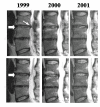Glucosamine and chondroitin sulfate supplementation to treat symptomatic disc degeneration: biochemical rationale and case report
- PMID: 12797867
- PMCID: PMC165439
- DOI: 10.1186/1472-6882-3-2
Glucosamine and chondroitin sulfate supplementation to treat symptomatic disc degeneration: biochemical rationale and case report
Abstract
Background: Glucosamine and chondroitin sulfate preparations are widely used as food supplements against osteoarthritis, but critics are skeptical about their efficacy, because of the lack of convincing clinical trials and a reasonable scientific rationale for the use of these nutraceuticals. Most trials were on osteoarthritis of the knee, while virtually no documentation exists on spinal disc degeneration. The purpose of this article is to highlight the potential of these food additives against cartilage degeneration in general, and against symptomatic spinal disc degeneration in particular, as is illustrated by a case report. The water content of the intervertebral disc is a reliable measure of its degeneration/ regeneration status, and can be objectively determined by Magnetic Resonance Imaging (MRI) signals.
Case presentation: Oral intake of glucosamine and chondroitin sulfate for two years associated with disk recovery (brightening of MRI signal) in a case of symptomatic spinal disc degeneration. We provide a biochemical explanation for the possible efficacy of these nutraceuticals. They are bioavailable to cartilage chondrocytes, may stimulate the biosynthesis and inhibit the breakdown of their extracellular matrix proteoglycans.
Conclusion: The case suggests that long-term glucosamine and chondroitin sulfate intake may counteract symptomatic spinal disc degeneration, particularly at an early stage. However, definite proof requires well-conducted clinical trials with these food supplements, in which disc de-/regeneration can be objectively determined by MRI. A number of biochemical reasons (that mechanistically need to be further resolved) explain why these agents may have cartilage structure- and symptom-modifying effects, suggesting their therapeutic efficacy against osteoarthritis in general.
Figures

Similar articles
-
Glucosamine supplementation demonstrates a negative effect on intervertebral disc matrix in an animal model of disc degeneration.Spine (Phila Pa 1976). 2013 May 20;38(12):984-90. doi: 10.1097/BRS.0b013e318286b31e. Spine (Phila Pa 1976). 2013. PMID: 23324939 Free PMC article.
-
Oral chondroprotection with nutraceuticals made of chondroitin sulphate plus glucosamine sulphate in osteoarthritis.Carbohydr Polym. 2014 Aug 30;109:126-38. doi: 10.1016/j.carbpol.2014.03.033. Epub 2014 Mar 27. Carbohydr Polym. 2014. PMID: 24815409 Review.
-
Comparative Analyses of Pharmaceuticals or Food Supplements Containing Chondroitin Sulfate: Are Their Bioactivities Equivalent?Adv Ther. 2019 Nov;36(11):3221-3237. doi: 10.1007/s12325-019-01064-8. Epub 2019 Sep 7. Adv Ther. 2019. PMID: 31494830 Free PMC article.
-
The effect of disc degeneration and facet joint osteoarthritis on the segmental flexibility of the lumbar spine.Spine (Phila Pa 1976). 2000 Dec 1;25(23):3036-44. doi: 10.1097/00007632-200012010-00011. Spine (Phila Pa 1976). 2000. PMID: 11145815
-
Naturocetic (glucosamine and chondroitin sulfate) compounds as structure-modifying drugs in the treatment of osteoarthritis.Curr Opin Rheumatol. 2003 Sep;15(5):651-5. doi: 10.1097/00002281-200309000-00022. Curr Opin Rheumatol. 2003. PMID: 12960496 Review.
Cited by
-
Disc size markedly influences concentration profiles of intravenously administered solutes in the intervertebral disc: a computational study on glucosamine as a model solute.Eur Spine J. 2014 Apr;23(4):715-23. doi: 10.1007/s00586-013-3142-5. Epub 2013 Dec 29. Eur Spine J. 2014. PMID: 24375329 Free PMC article.
-
The effects of glucosamine sulfate on intervertebral disc annulus fibrosus cells in vitro.Spine J. 2015 Jun 1;15(6):1339-46. doi: 10.1016/j.spinee.2013.11.058. Epub 2013 Dec 18. Spine J. 2015. PMID: 24361347 Free PMC article.
-
Glucosamine supplementation demonstrates a negative effect on intervertebral disc matrix in an animal model of disc degeneration.Spine (Phila Pa 1976). 2013 May 20;38(12):984-90. doi: 10.1097/BRS.0b013e318286b31e. Spine (Phila Pa 1976). 2013. PMID: 23324939 Free PMC article.
-
Efficacy of glucosamine, chondroitin, and methylsulfonylmethane for spinal degenerative joint disease and degenerative disc disease: a systematic review.J Can Chiropr Assoc. 2011 Mar;55(1):47-55. J Can Chiropr Assoc. 2011. PMID: 21403782 Free PMC article.
-
Re-appraising the potential of naringin for natural, novel orthopedic biotherapies.Ther Adv Musculoskelet Dis. 2020 Dec 8;12:1759720X20966135. doi: 10.1177/1759720X20966135. eCollection 2020. Ther Adv Musculoskelet Dis. 2020. PMID: 33343723 Free PMC article. Review.
References
-
- Antoniou J, Steffen T, Nelson F, Winterbottom N, Hollander AP, Poole RA, Aebi M, Alini M. The human lumbar intervertebral disc: evidence for changes in the biosynthesis and denaturation of the extracellular matrix with growth, maturation, ageing, and degeneration. J Clin Invest. 1996;98:996–1003. - PMC - PubMed
-
- Coventry MB, Ghormley RL, Kernohan JW. The intervertebral disc: its microscopic anatomy and pathology. I. Anatomy, development and pathology. J Bone Joint Surg Am. 1945;27:105–112.
-
- Coventry MB, Ghormley RL, Kernohan JW. The intervertebral disc: its microscopic anatomy and pathology. II. Changes in the intervertebral disc concomittant with age. J Bone Joint Surg Am. 1945;27:233–247.
-
- Coventry MB, Ghormley RL, Kernohan JW. The intervertebral disc: its microscopic anatomy and pathology. III. Pathologic changes in the intervertebral disc. J Bone Joint Surg Am. 1945;27:460–474.
Publication types
MeSH terms
Substances
LinkOut - more resources
Full Text Sources
Other Literature Sources
Medical

